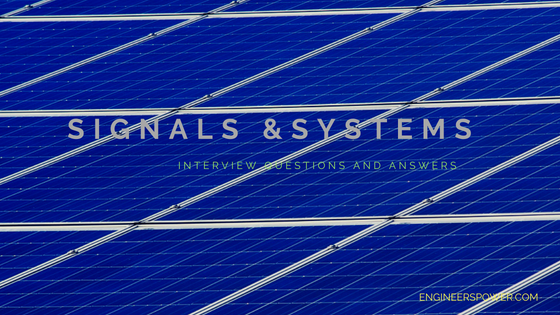SIGNALS AND SYSTEMS INTERVIEW QUESTIONS AND ANSWERS
Q.1. What we have to do, if the spectrum of a discrete signal is to be expanded?
Answer: We have to decimate the discrete signal.
Q.2. What do you mean by zero phase of the signal?
Answer: If the spectrum of a signal is having even symmetry around zero frequency then the signal is said to have zero phase.
Q.3. How you can represent recursive and non-recursive discrete time system with the help of constant coefficient difference equation?
Answer: Non-recursive system-
Y[n] = ax[n] + bx[n-1], where a and b are constant.
Response is not depending on previous response.
Recursive system-
Y[n] = ay[n-1] + bx[n] + cx[n-1], where a, b, c are constants.
Response is depending on previous response, so recursive response.
Q.4. What are the applications of initial and final value theorems?
Answer: The applications of initial and final value theorems are-
- The initial voltage on the capacitor or current through an inductor can be evaluated with the help of initial value theorem.
- The final charging voltage on capacitor or saturating currents through an inductor can be evaluated with the help of final value theorem.
Q.5. What is the range of frequency of CTFT and DTFT?
Answer: In CTFT the range of frequencies varies from -∞ to +∞ whereas in DTFT the range of frequencies varies from –π to +π.
Q.6. Why windowing is necessary for a sampled signal?
Answer: When a signal is sampled and FFT is performed directly then the first side lobe is only 14 dB less than the main lobe i.e. the SNR is very poor. Windowing of sampled signal is done to improve the ratio between main lobe and the first side lobe.
Q.7. What should be the condition for the time domain system to be stable and causal both?
Answer: The system is stable and causal both if all the poles lie in left half side of s-plane and ROC of Laplace transform is on right hand side of all the poles (i.e. it includes jw axis.
Q.8. What is the relation of power spectral density to autocorrelation?
Answer: Autocorrelation function and power spectral density form a Fourier transform pair.
Q.9. What do you mean by distributed parameter system?
Answer: If the size of the component is large with respect to the wavelength of highest frequency component present in the signal associated with it then it is called distributed parameter system. Example- coaxial cable.
Q.10. What do you mean by lumped parameter system?
Answer: If the size of the component is small with respect to the wavelength of highest frequency component present in the signal associated with it then it is called lumped parameter system. Example- electrical circuit.
Q.11. What are piecewise-defined signals?
Answer: Signals which cannot be represented by a single equation for all time but can be represented by a set of equations are called piecewise equations or piecewise-defined signals.
Q.12. What is Hilbert Transform?
Answer: Hilbert transform of a signal x(t) is defined as the transform in which phase angle of all components of the signal is shifted by ±90∘.
Q.13. What are passive and active filters?
Answer: A passive filter is a kind of electronic filter that is made only from passive elements – in contrast to an active filter, it does not require an external power source (beyond the signal). An active filter is a type of analog electronic filter, distinguished by the use of one or more active components and require an external power source.
Q.14. Is it possible to design a filter which can give good results both in time domain and frequency domain?
Answer: No it is not possible to design such kind of filter.
Q.15. What is the double curse effect of Aliasing?
Answer: Due to Aliasing high frequency contents are recovered at low frequency so both high frequency and low frequency contents are lost.
Q.16. What do you mean by sinusoidal fidelity?
Answer: sinusoidal fidelity is an important characteristic of linear system. If input to a linear system is a sine wave, the output will also be a sine wave at exactly the same frequency. Only the amplitude and phase can be different.
Q.17. What is the importance of unit impulse function?
Answer: One of the important characteristics of unit impulse is that very general signals can be represented as linear combination of delayed impulses.
Q.18. What is the difference between convolution and correlation?
Answer: In convolution one of the two signals is folded and shifted while in correlation none of the signal is folded but one signal is shifted to right or left.
Q.19. What do you mean by Gibbs phenomenon?
Answer: Gibbs phenomenon says that whenever there is abrupt discontinuity in the signal which is being sampled, the reconstructed signal will always have high frequency oscillations and as the number of samples increases the oscillations compress towards discontinuity but their maximum value remains the same.
Q.20. Can we interchange the sampling and quantization operations, means instead of sampling the signal first and then quantized, can we do quantization first and then sampling?
Answer: Yes we can interchange the sampling and quantization operations but the drawback is that it results in increased quantization noise.
Q.21. Can you able to reconstruct the original signal from sampled signal if it has been sampled at Nyquist rate?
Answer: No original signal cannot be reconstructed because in order to reconstruct the original signal from sampled signal when it is sampled at Nyquist rate, an ideal low pass filter is required which is impossible in real life to construct.
You may also like to read:
- Network interview questions and answers.
- EMFT interview questions and answers.
- Electronic devices interview questions and answers.
- Control system interview questions and answers.
- Digital electronics interview questions and answers.
- Communication system interview questions and answers.
- Analog circuits interview questions and answers.
